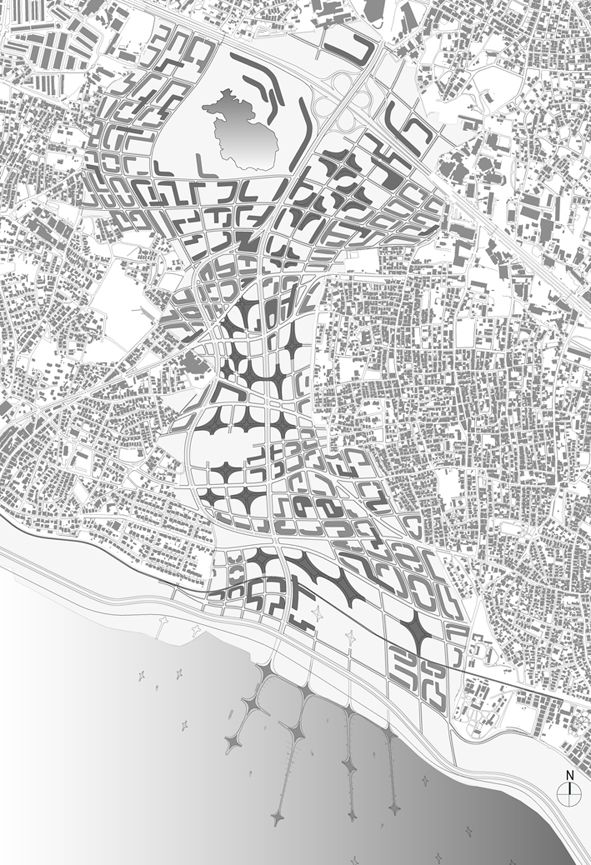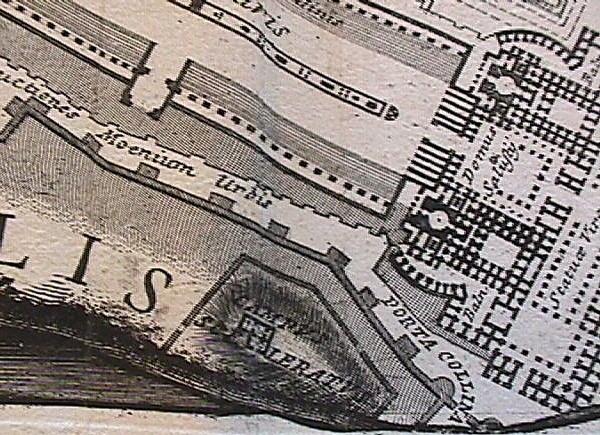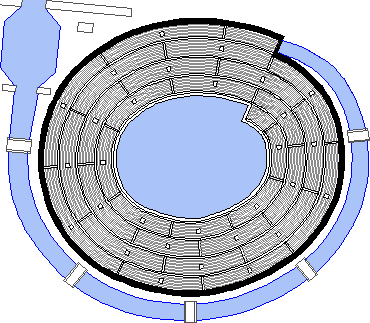2013.09.09 21:43
Obama names critic of Gehry's design to Eisenhower Memorial Commission to oversee DC project
And here I thought the first complaint was going to be that the scale is completely inappropriate for the context and site.
I'm still hoping no body notices that the design is much more Stalin/Soviet style than US/Patriotic style, though. Talk about completely inappropriate symbolism for the leading cold war president!
Hey, if you're gonna be black-listed, you might as well do it right, right?
2013.10.06 11:35
6 October
Read earlier: "...locale and history have simultaneous real and fabled coordinates, anchored both in actuality and in the archetypes of innocence and experience, paradise gained and lost... ...the reader enters a fictive world with its own unique operating principles, in which past and future conjoin to form a continual present in which the extraordinary meet the commonplace to defamiliarize and release an aura of strangeness and wonder... ...traditional oppositions--realism and fantasy, fact and illusion, history and myth, reason and irrationality--coming together in a complex of significance."
2013.10.11 15:31
Architecture Art and Earthquakes
It seems that the Bennesse Art Site is more [about] muse[um]ification "has saved the day" rather than "architecture has saved the day."
"The impossibility of using has its emblematic place in the Museum. The muse[um]ification of the world is today an accomplished fact. One by one, the spiritual potentialities that defined the people's lives--art, religion, philosophy the idea of nature, even politics--have docilely withdrawn into the Museum. "Museum" here is not a given physical space or place but the separate dimension to which what was once--but is no longer--felt as true and decisive has moved. In this sense, the Museum can coincide with an entire city (such as Evora and Venice, which were declared World Heritage Sites), a region (when it is declared a park or natural preserve), and even a group of individuals (in so far as they represent a form of life that has disappeared). But more generally, everything today can become a Museum, because this term simply designates the exhibition of an impossibility of using, of dwelling, of experiencing.
Thus in the Museum, the analogy between capitalism and religion becomes clear. The Museum occupies exactly the space and function once reserved for the Temple as the place of sacrifice. To the faithful in the Temple--the pilgrims who would travel across the earth from temple to temple, from sanctuary to sanctuary--correspond today the tourists who restlessly travel in a world that has been abstracted into a Museum."
Giorgio Agamben, "In Praise of Profanation" (2007).
In more than a few ways, the sentiments of the quotation relate directly to the (objectives of) the Bennesse Art Site, where even the (new) architecture now carries the added function of being a 'museum piece'. This is not to negatively criticize for what the art site is doing, but to bring what it's doing into finer focus.
Muse[um]ification (and the tourism that comes with it) may indeed become more and more a solution to the types of problems places like Inujima present. And then, beyond that, that is once the muse[um]ification has taken place, "The antidote then may well be to simply use museums."
| |
2013.10.11 17:12
Flint Flat Lot: What won and what got built.
I actually took the time to look at the photos offered, and I enjoyed looking at them, especially because they all seem very objective, i.e., very close to the reality--sometimes the structure looked to have it's intended effect, and sometimes it didn't; the unintended waviness of the surface, however, more often than not detracted from the mirror/reflective effect. What I did not expect was that the site itself is such a dud.
Did this project want to emulate the Kapoor mirror blob thing in that Chicago park? That's what I thought when I first read this thread. Kapoor's piece in Chicago probably cost a lot more than $25,000.
Funny, too, most of the architectural world wouldn't even know of the structure in Flint if it hadn't gone all wavy. Better yet, wouldn't it be great if the architects started having a very lucrative business designing wavy-mirrored houses?
"There's no such thing as bad publicity."
2013.10.11 18:59
The Sydney Opera House by Jørn Utzon Celebrates Its 40th Anniversary
...I've come to realize that the Sydney Opera House is for sure one of the greatest works of architectural hyperbole.
2013.10.29 08:34
Why won't you design what we (the public) want?
...something's not making sense: you say, "they [the public] simply want good housing," yet most of the housing in the US is currently done in a "traditional" style. Are you saying that this "traditional" housing currently produced in the US (which for the most part is developer designed) is not what the public wants?
If so, then why are you blaming architects and their education? You and the public should be aiming your complaints at home developers.
Also, if there are a good number of architects out there that design "traditionally", and if there are also a good number of people that want "traditional" architecture, and, for some reason, you are still not satisfied with the results, then it's the architects that practice "traditional" architecture that are to blame for not doing a better job.
If, however, what you really want is to see modern architectural design somehow eradicated, then you better face the facts and realize that that is just not going to happen.
2013.10.29 10:37
Why won't you design what we (the public) want?
If there is such a big market for traditional architecture, then the capitalist system of the US will more than likely cater to that market. More than anything else, the built environment of the US is a fairly clear representation of its concurrent market economy.
2013.11.09 11:11
Why won't you design what we (the public) want?
One of the saddest things about this whole thread is the overall passivity of both sides. And one of the greatest ironies is that the 'traditionalists' want change and the 'modernists' want things to stay as they are.
What's lacking from this 'argument' is the role of mediation (starting with the printed image through to the digital) and its effect on what people like/want.
| |
2013.11.22 22:13
22 November
2013.11.22: Patrik Schumacher himself posts twice within an Archinect news item.
I'd like to see a same scale comparison of Le Corbusier's Plan Voisin and ZHA's Kartal Pendik Masterplan.


subliminal/subversive reenactment?
Still remembering 1999.08.14 at Quondam:

| |
2013.11.25 11:44
25 November
Been reading "The Medium of Architecture" in Schumacher's The Autopoiesis of Architecture: A New Framework for Architecture (vol. 1). It's all very engaging, but, because of recent posting in the Parametrics Smackdown thread, I'm going to further pursue reading the book(s) within parametric methodology in mind, i.e., read along but with the additional notion of how the text may change as I implant my own thoughts/ideas (evoked by the text itself) into the text.
This is a primary quote from p. 346: "The ability to combine detail resolution with openness to future transformations is the decisive hallmark to the parametric model."
I also liked reading about the "epiphany" moment as presented on 353: "It was during this cycle of working with the action-reaction schema that the author first grasped the power of scripting and associative parameters."
2013.12.13 19:48
12 December

...it looks as if the Temple of Vesta is not within the Piranesi perspective 'view' of the Roman Forum. The three columns with entablature belong to the Temple of Castor and Pollux, and the round Temple of Vesta would be right in the center of the view within the clearing in front of the two tiny figures. I'm guessing the temple base was still buried in Piranesi's time, and the few columns of the round temple that are in the Forum today are a reconstruction of 20th century vintage. Note, too, how the church facade seen through the three columns does not exist in our time.
The Roman Forum is not delineated within the Ichnographia Campus Martius, but Piranesi did draw a reconstructed plan of the Roman Forum within volume one of La Antichita Romane--that plan is nowhere close to what we know the plan to be today.
"The Vestals, priestesses of the goddess Vesta, whose temple was opposite their house, were selected among the daughters of patrician families between six and ten years of age.
They were exempt from the common law, had many privileges and great political importance, often interposing to save a life, or to restore harmony at times of crisis. They sat in seats of honour at public games and were almost the only citizens allowed to drive within the walls. Their duty was to watch by night and by day the sacred fire in the Temple, and to guard the Palladium. If the fire was allowed to go out, the Vestal in charge was scourged for her carelessness; if she violated her vow of chastity, she was condemned to be buried alive."
The place where Vestals were buried, the Campus Sceleratus, is delineated within the Ichnographia Campus Martius, but, unless you are looking at an actual engraving of the Ichnographia, you are not likely to discern its label:

I believe that I once read somewhere that it was a criminal offense to murder any virgin in Rome, thus the quandary of how execute a fallen Vestal, hence live burial at the Campus Sceleratus.
By the way, the small exhibit at Quondam mentioned above was innuendo.
What I find interesting is that the notion of a god having sex with a virgin is at the very foundation of Christianity. Here's something I wrote just over 10 years ago:
Re: Bib. for Cyrillona's Mariology?
2003.08.09 13:32
John,
Thank you for the Graef citation. If Graef does indeed confuse Immaculate Conception with Annunciation/Incarnation, then this is one more example where such a mistake is made within modern scholarship. I have become very intolerant of this mistake after finding it several times within contemporary architectural theory texts. I even see this presence of misinformation compounded because it implicates not only authors, but editors/review peerage as well. This mistake needs broad/public attention within the realm of scholarship simply to cease the perpetuation of its existence.
It is the Annunciation, as reported by Luke 1:26-38, where a series of events are clearly described.
1. (26) The angel Gabriel is sent by God to Nazareth. The presence of an angel already constitutes a miraculous event, a theophany.
2. (27) The angel is sent to a betrothed virgin named Mary. Here Scripture clearly states that Mary is a virgin and that she is promised in marriage to Joseph.
3. (28) In greeting, Gabriel exalts Mary; "the Lord is with thee" reiterates the theophany, thus Mary's being "full of grace" and "Blessed among women" is Divinely sanctioned.
4. (29) Mary is troubled by such a greeting, signifying her overall innocence in this situation.
5. (30) Gabriel assures Mary of her safety within the theophany taking place.
6. (31) Gabriel 'announces' to Mary that she will conceive and subsequently give birth to a boy, Jesus.
7. (32-33) Gabriel Highly exalts the nature of Mary's announced offspring, indeed to the point of infinity.
8. (34) Mary exclaims confusion at the announcement, while she herself proclaims her virginity.
9. (35) Gabriel tells Mary the Holy Spirit will come upon her, the Most High will overshadow her, and the Holy One to be born will be called the Son of God. Gabriel essentially announces the soon forthcoming of the Trinity, a complete theophany.
10. (36) Gabriel then announces the Precursor, John the Baptist.
11. (37) "for nothing shall be impossible with God."
12. (38) Mary's ultimate reply, "Behold the handmaid of the Lord; be it done to me according to thy word," is extremely important on two counts. First, it is at the moment of Mary's complicity that the Incarnation (the Word becoming flesh) occurs. (Note Gabriel efficiently departs as soon as his task is complete.) Second, without Mary's complicity, the Incarnation would have been the result of a rape, not at all unlike the sexual relationship between Mars (a divinity) and Rhea Silvia (a Vestal Virgin), another reported theophany which progenerated Rome.
After the Annunciation/Incarnation comes the Visitation, where John the Baptist, when he for the first time is in the presence of the Incarnation, takes a noticeable pre-natal leap.
Piranesi further 'played' with the Pagan/Christian inversion of god and virgin via the Templum Martis/church of S. Agnese in Agone.
A lot of all the above was way in the back of my mind during the ZHA World Cup Stadium as vagina discussions. I wonder if Piranesi's spiraling mock sea-battle stadium within the Ichnographia Campus Martius, the Naumachia Domitiani, will become the inspiration for a new stadium designed within the next decade or so.

Also, I'm currently re-reading Tafuri's Architecture and Utopia, and I have a heightened awareness of the avant-garde architectural lineage that Tafuri sees the Ichnographia Campus Martius as the protogenitor of. I think it's now possible, however, to 'fabricate' a whole other avant-garde architectural lineage once one understands what the Ichnographia Campus Martius is really all about.
|